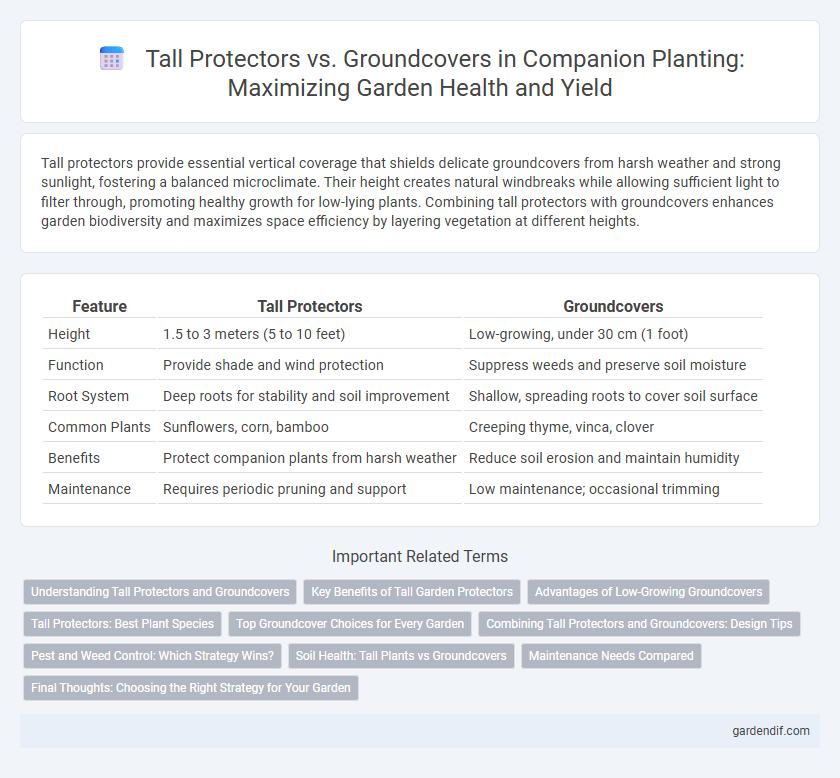
Tall protectors vs groundcovers Illustration
Tall protectors provide essential vertical coverage that shields delicate groundcovers from harsh weather and strong sunlight, fostering a balanced microclimate. Their height creates natural windbreaks while allowing sufficient light to filter through, promoting healthy growth for low-lying plants. Combining tall protectors with groundcovers enhances garden biodiversity and maximizes space efficiency by layering vegetation at different heights.
Table of Comparison
| Feature | Tall Protectors | Groundcovers |
|---|---|---|
| Height | 1.5 to 3 meters (5 to 10 feet) | Low-growing, under 30 cm (1 foot) |
| Function | Provide shade and wind protection | Suppress weeds and preserve soil moisture |
| Root System | Deep roots for stability and soil improvement | Shallow, spreading roots to cover soil surface |
| Common Plants | Sunflowers, corn, bamboo | Creeping thyme, vinca, clover |
| Benefits | Protect companion plants from harsh weather | Reduce soil erosion and maintain humidity |
| Maintenance | Requires periodic pruning and support | Low maintenance; occasional trimming |
Understanding Tall Protectors and Groundcovers
Tall protectors, such as sunflowers or hollyhocks, provide vertical structure and shield more delicate plants from wind and intense sunlight, enhancing garden microclimates. Groundcovers like creeping thyme or ajuga form dense mats that suppress weeds, retain soil moisture, and prevent erosion, creating a stable base for taller plants. Combining tall protectors with groundcovers optimizes plant health by balancing protection from environmental stressors with effective ground-level soil management.
Key Benefits of Tall Garden Protectors
Tall garden protectors offer superior defense against pests and harsh weather, creating an ideal microclimate for companion plants to thrive. Their height provides natural shade, reducing soil evaporation and promoting moisture retention, which benefits low-growing groundcovers. These vertical barriers also improve air circulation and reduce weed competition, enhancing overall garden health and productivity.
Advantages of Low-Growing Groundcovers
Low-growing groundcovers offer excellent soil erosion control by forming dense mats that retain moisture and suppress weed growth more effectively than tall protectors. They enhance landscape aesthetics with continuous, low-maintenance coverage and provide better habitat for beneficial insects and small wildlife. Their low profile reduces wind damage and prevents overcrowding, ensuring healthier growth for surrounding plants.
Tall Protectors: Best Plant Species
Tall protectors like bamboo, holly, and ornamental grasses serve as excellent companions by creating natural barriers that shield groundcovers from harsh wind and excessive sunlight. Species such as Leyland cypress and giant miscanthus provide height and dense foliage, enhancing garden structure while supporting the growth of low-lying plants. Selecting tall protectors with deep root systems ensures soil stability and moisture retention, vital for thriving groundcover companions.
Top Groundcover Choices for Every Garden
Groundcovers like creeping thyme, sedum, and ajuga provide low-maintenance, dense coverage that suppresses weeds and enhances soil moisture retention. Tall protectors such as ornamental grasses and bamboo offer vertical interest and create natural barriers against pests and harsh weather. Selecting top groundcover choices ensures year-round garden health and complements taller companion plants for a balanced ecosystem.
Combining Tall Protectors and Groundcovers: Design Tips
Combining tall protectors such as sunflowers or hollyhocks with low-growing groundcovers like creeping thyme or ajuga creates a layered landscape that maximizes garden space and visual interest. Position tall protectors at the back or center of the garden bed to provide height and shelter, while groundcovers fill in gaps, suppress weeds, and maintain soil moisture around their roots. Selecting plants with complementary colors, textures, and growth habits enhances biodiversity and creates a harmonious, thriving ecosystem in the garden.
Pest and Weed Control: Which Strategy Wins?
Tall protectors like sunflowers and hollyhocks act as natural barriers against pests by creating a physical shield and attracting beneficial insects that prey on harmful pests, thereby reducing the need for chemical pesticides. Groundcovers such as clover and creeping thyme suppress weed growth by forming dense mats that block sunlight and compete for nutrients, effectively minimizing weed proliferation. For integrated pest and weed management, combining tall protectors with groundcovers offers a synergistic approach that enhances biodiversity and maintains healthier garden ecosystems.
Soil Health: Tall Plants vs Groundcovers
Tall protectors improve soil aeration by enhancing root penetration and promoting microbial diversity, which strengthens soil structure and nutrient cycling. Groundcovers excel at reducing soil erosion and moisture evaporation through dense, low-lying foliage that shields the soil surface. Combining tall plants and groundcovers creates a synergistic effect on soil health, balancing aeration with protection against erosion and moisture loss.
Maintenance Needs Compared
Tall protectors require regular pruning and staking to maintain structure and prevent legginess, while groundcovers demand minimal trimming and natural spreading to suppress weeds. Groundcovers are generally lower maintenance with less frequent watering and fertilizing needs compared to tall protectors, which often need more intensive care to thrive. Effective companion planting combines these growth habits to balance upkeep and ensure healthy, manageable garden beds.
Final Thoughts: Choosing the Right Strategy for Your Garden
Tall protectors create vertical interest and shield delicate plants from harsh wind or sun, enhancing garden microclimates and supporting biodiversity. Groundcovers suppress weeds, retain soil moisture, and prevent erosion, promoting healthier root systems and reducing maintenance efforts. Selecting the right strategy depends on your garden's specific needs, climate conditions, and desired aesthetic, balancing protection with growth optimization.
Tall protectors vs groundcovers Infographic

 gardendif.com
gardendif.com